Civil War Surgical and Medical Text Books
Page Eleven
Authors:
United States. Surgeon-General's Office: Barnes, Joseph K.; Woodward,
Joseph Janvier;
Smart, Charles;
Otis, George Alexander;
Huntington, David Lowe,
City of NY, Medical Department;
Medical and Surgical History of the War of the Rebellion (1861-1865)
Six volumes 1870 to 1888
The Medical and Surgical History of
the War of the Rebellion (American Civil War of 1861-1865) is a
multi-volume (6 hard bound volumes in green
cloth with gilt
lettering along spine.)
set originally published after the Civil War, detailing surgical cases
and diseases and most importantly, the surgeons and assistant surgeons
who performed the surgery. This work consists of numerous statistical summaries
relating to diseases, wounds, pathology, post-mortem reports, and deaths in both the Union and
Confederate armies, with the overwhelming bulk of material formed from
the reports of U.S. medical directors, surgeons, doctors, and hospital
staff during the War. The data collected during the War
helped propel medical and surgical knowledge the the United State to new
heights. The understanding of pathology gained through post-mortem
analysis was invaluable in expanding the future medical education of
surgeons and medical researchers.
In addition to the statistical summaries, excerpts
are presented from case studies of tens of thousands of victims of
disease and injury during the War. Not only is this account the basic
source for medical data, but it comprises one of the finest collections
of material relating to individual soldiers. Hundreds of engravings,
charts, and tables, as well as many color plates accompany the text. The
names of the surgeons who submitted these case studies are almost always
included, so this set can be helpful in tracking where an individual
surgeon was at various times.
______________________
"The Congressional Printer is hereby
authorized to print and bind five thousand additional copies of the
Medical and Surgical History of the War of the Rebellion; one thousand
of which shall be for the use of the Senate, three thousand for the use
of the House of Representatives, and one thousand for distribution by
the Surgeon General of the Army."
In accordance with the foregoing provision of the law, a second issue of
the First Part of the Medical and Surgical History has been prepared,
corresponding, as nearly as practicable, with the first issue. Obvious
typographical errors have been corrected; but a minute revision of the
text has not been attempted, as the time of the officers engaged on the
work is fully occupied with the preparation of the second and third
parts of this large statistical work.
JOSEPH K. BARNES, Surgeon General
United States Army.
WAR DEPARTMENT,Surgeon General's Office, April, 1875.
______________________
This set consists of three medical
volumes (Part 1 Vol. 1 - 365 pages long, Part 2 Vol. 1 - 869 pages long,
and Part 3 Vol. 1 - 989 pages long) AND three surgical volumes (Part 1
Vol. 2 - 650 pages long, Part 2 Vol. 2 - 1024 pages long, and Part 3
Vol. 2 - 986 pages long). These volumes were published between 1870 and
1888 from the information collected by the Surgeon-General's office
during the Civil War. There is also a searchable DVD for this
information, which this researcher uses rather than 'bending' these
invaluable original textbooks.

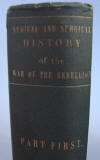
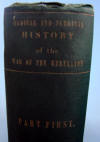

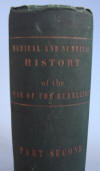


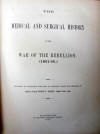
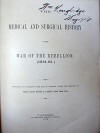
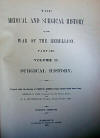
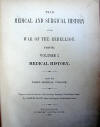

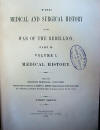

Click on images to enlarge
|
Stamp in one volume
Cincinnati physicians
established the Academy of Medicine in 1857. It served as
primarily a social and educational club for local
physicians. Members met together to share knowledge, to
establish standards for medical education, and to debate
medical treatments for various illnesses affecting the
community. The Academy of Medicine has continually operated
since the 1850s.
|
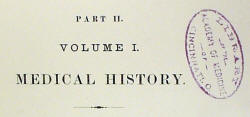
Stamp
of Academy of Medicine
Cincinnati, Ohio |
THE MEDICAL AND SURGICAL
HISTORY OF THE WAR OF THE REBELLION
Surgical Pathology in the Era of the Civil War:
The Remarkable Life and Accomplishments of
Joseph Janvier Woodward, MD
Amy V.
Rapkiewicz, MD; Alan Hawk, BA; Adrienne Noe, PhD; David M.
Berman, MD, PhD
More Americans (Confederate
and Union) died in the Civil War than any other conflict in
American history. Following the end of hostilities, Woodward was
commissioned to coauthor the medical section of the MSHWR.
This work is acknowledged to be the first major academic medical
accomplishment in the United States. In the medical section of
the MSHWR, Woodward's meticulous insight and attention to
detail are evident in the description, organization, and
tabulation of diseases found in soldiers of the Civil War. The
monthly records of sickness and mortality submitted by more than
200 hospitals and the medical directors of 8 armies were
painstakingly compiled, and the troops were stratified based on
active versus volunteer, “colored” versus white, officers versus
enlisted men, and American versus foreign born. The total number
of Union deaths from the commencement to the close of the Civil
War was tabulated at 304 369,
with 186 369,
with 186 216
deaths resulting from disease and the remainder from trauma and
other causes. 216
deaths resulting from disease and the remainder from trauma and
other causes.
“Camp diarrhea,”
dysentery, and “camp fevers” are listed as the most frequent
causes of nontraumatic death; they resulted from overcrowding,
poor hygiene, and malnutrition. Woodward noted the severity in
the MSHWR, commenting: “These disorders occurred with
more frequency and produced more sickness and mortality than any
other form of disease. …Soon no army could move without leaving
behind it a host of victims.” In fact, the adage that a soldier
needed “guts” arose during this era.
For example, in 1862, the “monthly mortality from diarrhea and
dysentery among the white troops” reached its maximum of 128 per
1000 soldiers during July, which correlated with General George
McClellan's disastrous Peninsula Campaign. By the end of the
war, Woodward observed, 1 soldier died for every 30 cases of
acute diarrhea or dysentery. In unusually clear and explicit
writing for the era, Woodward details the effect of region and
season on the cases of dysentery, microscopic analysis of the
stools, postmortem gross and microscopic appearance of the
bowel, treatment of the condition, and known associated
complications. These gross and microscopic descriptions and
pictures were intended to remove independent-observer
variability and create images that could be reproduced and
studied for future reference comparison and diagnostic purposes.
It was hoped that the accurate descriptions would facilitate
etiologic subclassification of the various types of
gastrointestinal diseases and lead to a better understanding of
prevention and treatment.
____________________
Medical/Surgical
History--Part I, Volume II
Prepared, under the direction of JOSEPH K. BARNES, Surgeon
General United States Army,
By George A. Otis, Assistant Surgeon United States Army.
Continue to Page 12
Medical Book Collection
Pages:
1
|
1a
|
2
|
2a
|
3
|
3a
|
4
|
4a
|
5
|
5a |
6
|
7
|
8
|
9
|
See information on
Medical education and lecture cards
during and before the Civil War
|
Wanted: Medical
textbooks marked for the U.S.A. Medical or Hospital Dept. |
|
|